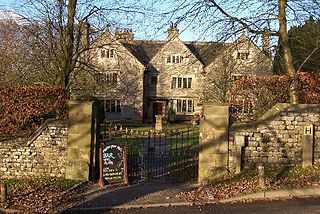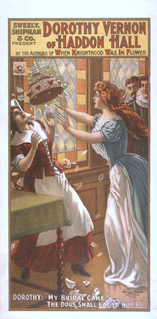
Bakewell is a small market town and civil parish in the Derbyshire Dales district of Derbyshire, England, well known for the local confection Bakewell pudding. It is located on the River Wye, about thirteen miles (21 km) southwest of Sheffield. In the 2011 census the civil parish of Bakewell had a population of 3,949. The town is close to the tourist attractions of Chatsworth House and Haddon Hall.

John Manners, 8th Earl of Rutland, was an English politician who sat in the House of Commons from 1640 until 1641 when he inherited the peerage.

Okeover Hall is a privately owned Grade II* listed country house in Staffordshire. It is the family seat of the Okeover family, who have been in residence since the reign of William Rufus. The house lies close to the border between Staffordshire and Derbyshire, which lies on the far side of the small River Dove. The Hall is not open to the public.

Tissington Hall is an early 17th-century Jacobean mansion house in Tissington, near Ashbourne, Derbyshire. It is a Grade II* listed building.

Duffield Hall is a 17th-century country house situated in the Amber Valley, Derbyshire and the former headquarters of the Derbyshire Building Society. It is a Grade II* listed building.
Butterley Hall is an 18th-century country house near Ripley, Derbyshire which now serves as the headquarters of the Derbyshire Constabulary. It is a Grade II listed building.

Hassop Hall is a 17th-century country house near Bakewell, Derbyshire which is now operated as a hotel. It is a Grade II* listed building.
Middleton Hall is a restored 17th-century country house at Stoney Middleton, Derbyshire. It is a Grade II listed building.
Walton Hall is a late 18th-century country house, now a farmhouse, situated at Foljambe Avenue, Walton, Chesterfield. It is a Grade II listed building.
Somersall Hall is a small country house near Brampton, Chesterfield, Derbyshire. It is a Grade II listed building.

Parwich Hall is a privately owned 18th-century mansion house at Parwich, near Ashbourne, Derbyshire Dales. It is a Grade II* listed building.

Burton Closes is a 19th-century country house, now in use as a residential nursing home, situated at Haddon Road, Bakewell, Derbyshire. It is a Grade II* listed building.
The Vernon family was a wealthy, prolific and widespread English family with 11th-century origins in Vernon, Normandy, France. Their extant titles include Baron Vernon and Vernon baronets of Shotwick Park.

Barlow Woodseats Hall is a Grade II* listed manor house situated at Barlow Woodseats, on the edge of the village of Barlow, in Derbyshire. It remains the only manor house in the Parish of Barlow, and the current house dates from the early 17th century, although there are much earlier origins to before 1269.

Hartington Hall is a much altered and extended 17th-century manor house at Hartington, Derbyshire, now a youth hostel.

Stockerston Hall is a late-18th-century English country house in Leicestershire, near the town of Uppingham, Rutland. It is a Grade II listed building.
Alderley Old Hall is the remaining part of a former 17th-century manor house near the village of Nether Alderley, Cheshire, England. It stands adjacent to the mill pond of Nether Alderley Mill, a loop of which acts as a moat. The hall is recorded in the National Heritage List for England as a designated Grade II* listed building.

George Vernon was and a prosperous and hospitable landowner and MP in Derbyshire, who came from a long line of wealthy landowners. He was the son of Richard Vernon and Margaret Dymoke. His family seat was at Haddon Hall, England's best preserved medieval manor house and today a major tourist attraction. He was a Member (MP) of the Parliament of England for Derbyshire in 1542.

Dorothy Vernon, the younger daughter of Sir George Vernon and Margaret nee Talbois, was the heiress of Haddon Hall, an English country house in Derbyshire with its origins in the 12th century. She married John Manners in 1563. The couple's descendants, the Dukes of Rutland, continue to own Haddon Hall. A legend grew up in the 19th century that Vernon and Manners eloped, and a number of novels, dramatisations and other works of fiction have been based on the legend.


















